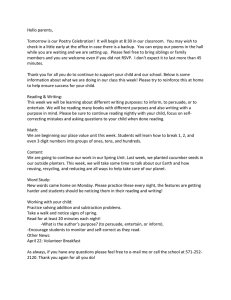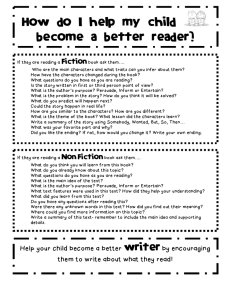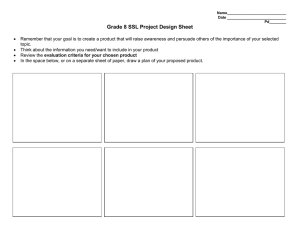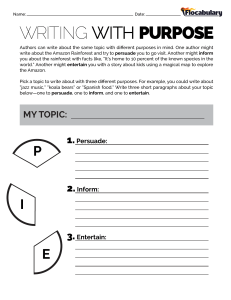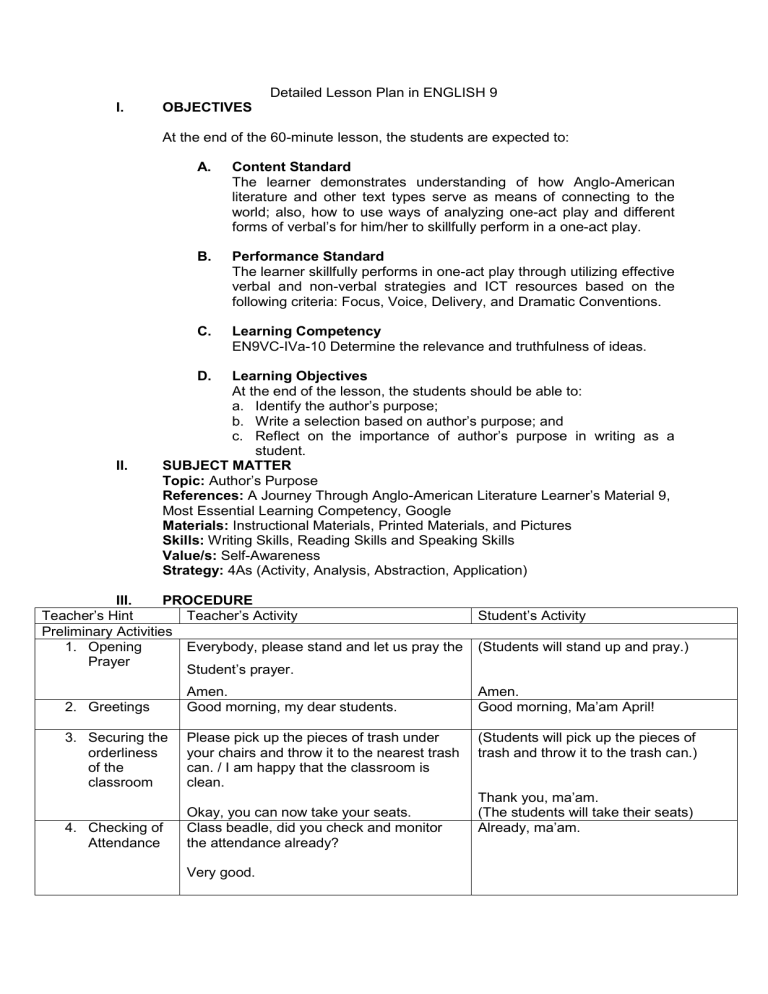
Detailed Lesson Plan in ENGLISH 9 I. OBJECTIVES At the end of the 60-minute lesson, the students are expected to: A. Content Standard The learner demonstrates understanding of how Anglo-American literature and other text types serve as means of connecting to the world; also, how to use ways of analyzing one-act play and different forms of verbal’s for him/her to skillfully perform in a one-act play. B. Performance Standard The learner skillfully performs in one-act play through utilizing effective verbal and non-verbal strategies and ICT resources based on the following criteria: Focus, Voice, Delivery, and Dramatic Conventions. C. Learning Competency EN9VC-IVa-10 Determine the relevance and truthfulness of ideas. D. II. Learning Objectives At the end of the lesson, the students should be able to: a. Identify the author’s purpose; b. Write a selection based on author’s purpose; and c. Reflect on the importance of author’s purpose in writing as a student. SUBJECT MATTER Topic: Author’s Purpose References: A Journey Through Anglo-American Literature Learner’s Material 9, Most Essential Learning Competency, Google Materials: Instructional Materials, Printed Materials, and Pictures Skills: Writing Skills, Reading Skills and Speaking Skills Value/s: Self-Awareness Strategy: 4As (Activity, Analysis, Abstraction, Application) III. PROCEDURE Teacher’s Hint Teacher’s Activity Preliminary Activities 1. Opening Everybody, please stand and let us pray the Prayer Student’s prayer. Student’s Activity (Students will stand up and pray.) 2. Greetings Amen. Good morning, my dear students. Amen. Good morning, Ma’am April! 3. Securing the orderliness of the classroom Please pick up the pieces of trash under your chairs and throw it to the nearest trash can. / I am happy that the classroom is clean. (Students will pick up the pieces of trash and throw it to the trash can.) 4. Checking of Attendance Okay, you can now take your seats. Class beadle, did you check and monitor the attendance already? Very good. Thank you, ma’am. (The students will take their seats) Already, ma’am. I. ACTIVITY A. Review Last time, what was our topic? We discussed about fact and opinion, ma’am. Exactly! We tackled about judging the relevance and truthfulness of ideas, and to determine whether the material is truthful and relevant, we need to consider those aspects, which are the fact and opinion. No, ma’am. When we say fact, what do we mean by this word? It has evidences to prove it and it is not debatable, ma’am. Very good! How about opinion? Opinion is based on someone’s beliefs or perspectives about something, and it is debatable. Correct! Yesterday, you also learned how to make or construct fact and opinion statements. B. Motivation Now, I know you are already ready to gain new knowledge, but before we go to our formal discussion, let us have this activity first. In this activity, you will be connecting the literary pieces onto its author. You will paste the picture of the author beside his/her masterpiece. Do you understand? Alright, let us start now. Romeo and Juliet Sorry, Wrong Number The Lottery Yes, ma’am. Excellent, class! You were able to connect the authors to their own literary text which has become famous. About authors, ma’am? Based on the activity, what do you think is our topic for today? Do you have any idea? C. Presentation of Objectives D. Diagnostic Testing Alright, for today’s lesson, we will discuss all about authors and their purpose in writing their works or literary text. In short, we will talk about Author’s Purpose. At the end of the lesson, the students should be able to: a. Identify the author’s purpose; b. Write a selection based on author’s purpose; and c. Reflect on the importance of author’s purpose in writing as a student. Pre-Test Direction: Choose the shape of the correct answer, and draw your answer on the blank provided before each item. ______1. It is the main reason why authors write their selections. Author’s Purpose Truthfulness Evidence Relevance ______2. Which author’s purpose is to convince a reader to believe an idea? To inform To describe To persuade To entertain ______3. Brochure and travel guides are examples of this author’s purpose. To inform To describe To persuade To entertain ______4. Which author’s purpose is to relate a story or recount events, and the author uses narrative writing? To inform To describe To persuade Answers: 1. 2. 3. 4. 5. To entertain ______5. Encyclopedias and books are examples of this author’s purpose. To inform To describe To persuade To entertain Alright! Most of you got the correct answers At this junction, let us discuss now it. II. ANALYSIS Discussion In our Pre-Test, most of your classmates got the correct answer. Let us now discuss it. Our topic for today is author’s purpose. Now, who can define author’s purpose based on our pre-test activity? Ma’am, author’s purpose refers to the reasons or what is the purpose of the author why he/she is writing his/her work. Very good! When we say author’s purpose, it really refers to author’s reason he/she has for writing a selection. It always answers the question “Why.” Why the author wrote his/her work. Now, are you familiar with this? Yes, ma’am. What’s this? It’s a pie, ma’am. Very good! Did you know that this has connection with the author’s purpose? In what way, ma’am? Alright, let me explain it to you. When you hear author’s purpose, just think of the food or word pie. ersuade nform ntertain Because P stands for Persuade, I, stands for Inform and E stands for Entertain. Normally, there are only three author’s purpose, but today, we will also tackle the fourth one. escribe Okay, so it will now become PIED, persuade, inform, entertain and describe. When we are talking about the author’s purpose, always think of the word PIED. Do you get it? Yes, ma’am. Alright, let us discuss it one by one. REASONS WHY AUTHOR’S WRITE: 1. TO PERSUADE Please read the definition of this purpose. to convince a reader to believe an idea or to take a course of action or to influence the reader, the author uses persuasive writing. Persuasive pieces are usually non-fiction. There are facts, it also contains the author’s opinions. Examples: Advertisement commercials, newspaper editorial, Political speeches, an essay urging readers to recycle. 2. TO INFORM Kindly read its meaning. To inform or teach the reader, the author uses expository writing. If the author’s purpose is to inform, you will learn something from the selection. Information pieces sometimes use one or more of the following: facts, details/instructions, places, events and people. Examples: textbooks, cookbooks, newspapers, encyclopedias, biographies news report. 3. TO ENTERTAIN Who wants to read the meaning of this purpose? To relate a story or recount events, an author uses narrative writing. One goal of writing may be to tell a story or to simply entertain and provide enjoyment for the reader. Examples: Harry Potter books, Poems about love, Script for a TV show. 4. TO DESCRIBE Please read the meaning of the purpose to describe. Examples: Travel guides, brochures, charts, instructions. To tell what something looks like, sounds like, or feels like, the author uses descriptive writing. Authors use descriptive facts, opinions and reasons to get the point across. Now, let’s try to identify the purpose of these examples: The giant panda is a bearlike animal that has thick white fur with black markings on its ears, limbs, shoulders, and around its eyes. Joe had been fishing for over two hours without a single bite. Suddenly, there was a nibble at the end of his fishing line. He stood up on the boat and leaned out too far. Just then, there was a sharp yank on the line. Joe fell overboard and landed head first into the water. Joe and his friends laughed and laughed. Dogs are the best pets. They are very loving and helpful. It’s fun to teach them new tricks. You should get a dog. Rooms are both comfortable and elegant with full baths, sturdy and rustic wooden furniture. In addition, suites include an extra sitting room. The hotel has spacious parking where visitors could park their vehicles easily. Moreover, the entire Answers: To inform To entertain To persuade To describe hotel building has wireless highspeed Internet and it’s free. III. ABSTRACTION Okay class, we are now done discussing. Now, my question is why does author’s purpose matter? Any idea? . It matters because understanding not only the "why" the author wrote the story but the "how" the author wrote the story tunes us in to what we should know by the end of the text. Essentially, understanding the reason behind the writing will help with the understanding of the writing. Very good, because the author is trying to tell us something, also, at the end of every texts they wrote, we can gain new knowledge or even moral lessons from the stories. Any other answer? It can also help us to consider the author’s values and perceptions in life. Alright, since most of the authors write based on their own experiences, sometimes, they are integrating their values and beliefs in their works, that’s why we can understand their point of views and also learn something from them. Any other idea? IV. It will also help us to form our own ideas and thought. Yes, correct! Since we have this purpose “to persuade” we can also be encouraged to form our thoughts and ideas depending on (Students’ answer may vary.) their ideas. APPLICATION At this juncture, get ¼ sheet of paper. Directions: Determine the author’s purpose (to persuade, to inform, to entertain or to describe) used in the sentence, and write your answer on the blank provided before the number. _________1. A five-paragraph essay where a student argues that people should recycle and not litter. _________2. An encyclopedia entry about endangered animals and efforts to protect them. _________3. A map of the world, showing all continents, countries, and oceans. _________4. A Garfield comic from the newspaper in which Garfield hates Mondays and likes Lasagna. Answers: 1. To persuade 2. To inform 3. To inform 4. To entertain 5. To describe 6. To entertain 7. To describe 8. To entertain 9. To persuade 10. To persuade _________5. As soon as I opened the door and stepped into Aunt Mabel’s house, the aroma of warm blueberries rushed forward to greet me. I followed the scent into the kitchen, where my gaze fell upon a blueberry pie with a beautiful, perfectly golden lattice crust. ________6. The play Romeo and Juliet by William Shakespeare. ________7. An essay describing a beautiful day spent in the mountains. ________8. Rabbit thought Turtle was slow. So, rabbit and turtle have a race. Rabbit fell asleep and turtle won the race. ________9. Advertisers use the phrase “Buy 1 Take 1 free.” ________10. Mrs. Moore is the best teacher in this school! She comes early and stays late. You should vote for her to be the Teacher of the Year, because she loves her job! She deserves this honor. So, go out and vote for Mrs. Moore! V. EVALUATION The class will be divided into four (4) groups. Each group will be writing a selection with the author’s purpose (to persuade, to inform, to entertain, to describe) Each group will have a task in writing a selection using author’s purpose. Group 1 – TO INFORM Ideas: -Write an excuse letter informing the teacher that you can’t attend the class. - Make a recipe of your favorite dish. Group 2 – TO PERSUADE Idea: - Create a paragraph/ advertisement encouraging people to buy a product. Group 3 – TO ENTERTAIN Idea: -Write a funny story Group 4 – TO DESCRIBE Idea: -Choose one tourist spot in Bicol, and describe it in one paragraph. VI. ASSIGNMENT Give the definition of the following words: 1. Faulty Logic 2. Unsupported Facts 3. Emotional Appeal
